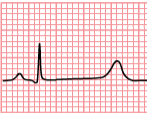Long QT syndrome
(Redirected from Long QT Syndrome)
| Long QT syndrome | |
 | |
|---|---|
| Type 3 Long QT Syndrome | |
| ICD-10 | I45.8 |
| ICD-9 | 426.82 |
| DiseasesDB | 11104 |
| MeSH | D008133 |
|
Long QT Syndrome Microchapters |
|
Diagnosis |
|---|
|
Treatment |
|
Case Studies |
|
Long QT syndrome On the Web |
|
American Roentgen Ray Society Images of Long QT syndrome |
For patient information, click here.
Long QT syndrome is one of the many causes of QT prolongation. For a complete review of QT prolongation in general, click here.
Editor-In-Chief: C. Michael Gibson, M.S., M.D. [2]
Synonyms and keywords: LQTS; long QT; congenital long QT; congenital long QT interval
Overview
Historical Perspective
Classification
Pathophysiology
Differentiating Long QT Syndrome from other Diseases
Epidemiology and Demographics
Risk Stratification
Screening
Natural History, Complications and Prognosis
Diagnosis
History and Symptoms | Electrocardiogram | Genetic Studies | Other Diagnostic Studies
Treatment
Medical Therapy
Surgery
Primary Prevention
Secondary Prevention
Contraindicated medications
Long QT syndrome is considered an absolute contraindication to the use of the following medications: